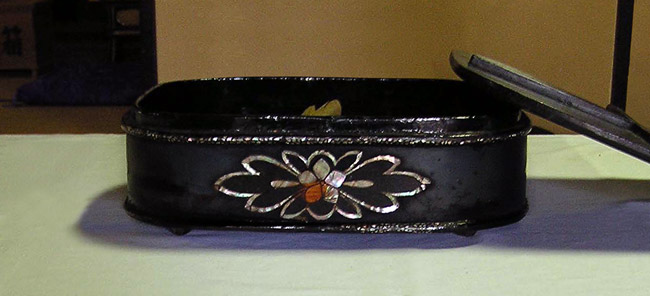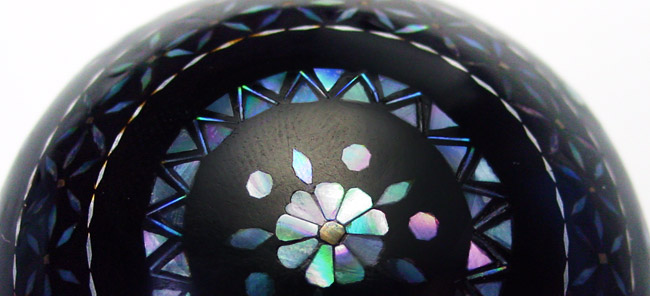|
||
 |
||
The raden technique, introduced from Tang dynasty China to Nara period Japan, was used with *mokuga Ψζ (mosaic), kohaku ΰζΰί (amber) and taimai ΰάΰξ (tortoise shell). Taimai, also called bekkou κb, was used from the Nara period. Taimaibari ΰάΰξ£θ is a one kind of suki-e §G (transparent painting) technique in which tortoise shell is covered over gold and silver foil and paint, and uses the *zougan ΫΖ (inlay) technique together with raden. Raden techniques developed greatly in the second half of the Heian period and were applied to architecture in combination with makie. Through the Kamakura period, raden was often applied to saddles. In the Muromachi period, Chinese and Korean raden ware was highly valued, and Japanese raden was influenced by them. In the Momoyama period, it was adopted into Nanban art nanban bijutsu μΨόp (see *nanban byoubu μΨ ). Honnami Kouetsu {’νυx (1558-1637) and Ogata Kourin φ`υΤ(1658-1716) used raden and makie techniques. Raden techniques were also used for *inrou σβΔ (seal case), combs and scabbards. Famous raden craftsmen include Ikushima Toushichi Ά‘΅ in the early Edo period, Aogai Choubee ΒL·Ίq and Somada zaiku [cΧH in the mid-Edo period, and Shibayama zaiku ΕRΧH in the late Edo period.


2@The technique originated in the Near East and its use eventually was imported to Japan from China in the 8c. Many early examples are to be found in the *Shousouin ³q@ in Nara. During and after the Heian period, rade was frequently combined with *makie ͺG lacquer techniques. Buddhist dais *shumidan {νd, can be seen in the Byoudouin *Hououdou ½@P° and Taimadera *Mandaradou ΦδΆ °.
@
(C)2001 Japanese Architecture and Art Net Users System.@No reproduction or republication without written permission.
fΪΜeLXgEΚ^ECXgΘΗASΔΜRecΜ³f‘»E]ΪπΦΆά·B

